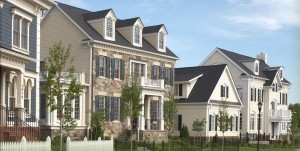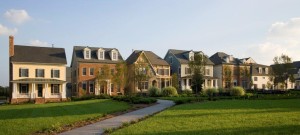If you ask developer Stuart Greenebaum how he feels about Maple Lawn Farm, the Traditional Neighborhood Design (TND), mixed-use community he developed in Howard County, Maryland, he will sum up the experience with one phrase: “the juice was worth the squeeze.”
The 600+ acre project, which was approved in the late 1990s to be built over 11 years, was to be 1,340 residential units and 1,862,000 square feet of office and retail. Even in the depths of this Great Recession, Maple Lawn Farm has managed to build more than 100 units per year, close to the maximum of 120 allowed. The existing office and commercial space is more than 99 percent leased, despite the fact it’s leasing at $6 to $7 per square foot more than comparable space in Howard County.
 With the many new developments being built with TND concepts of walkability, civic gathering spaces and a greater mix of uses, one might think that obtaining financing and approval for such projects would not be difficult and that financial and regulatory approvals would be a “slam dunk.” However, developers still face challenges when trying to patch together a master-planned community that includes both a mix of residential uses and of land uses (i.e., retail, office and civic spaces.)
With the many new developments being built with TND concepts of walkability, civic gathering spaces and a greater mix of uses, one might think that obtaining financing and approval for such projects would not be difficult and that financial and regulatory approvals would be a “slam dunk.” However, developers still face challenges when trying to patch together a master-planned community that includes both a mix of residential uses and of land uses (i.e., retail, office and civic spaces.)
One technique the builders employed was to acquire lots in a checkerboard fashion, rather than in large pods as is frequently done. This allowed the builders to be widely interspersed throughout the development, giving the community an organic feel. The architecture of the single-family homes reflects the Georgian and colonial architectural vernacular of the Chesapeake region. Miller and Smith have also begun a community of rowhouses called the Adams- Morgan collection, based on a popular area in Washington, D.C., which architecturally reflects the neo-colonial streetscape of that neighborhood. The single-family and townhouse homes generally offer minimal yards on each lot, but have plenty of public open space available in the project that can be used by residents for outside activities. Oftentimes, busy professional families prefer the low-maintenance lifestyle that minimum yards in a TND development typically offer.
In today’s difficult development market, financing a complex, mixed-use project can make a challenging project all that more difficult. Lenders want to see that the retail and office spaces will be able to attract viable tenants at reasonable costs. Often, the architectural detailing and style required for a TND project and the extra touches for streetscaping (such as park benches, lampposts, and additional landscaping) for TND or mixed use can add to costs compared to what a conventional project might need. This can force the developer to charge higher rents.
 One of the greatest criticisms of the TND concept is that it is sometimes more difficult for commercial, especially retail, to succeed. This is because of the higher cost of building and the reduced accessibility by automobile, scarcer parking, and smaller building footprints, which limits big box retailers. There are also a finite number of nearby residential units to support retail during the initial development phase and lower visibility to major thoroughfares compared to conventional retail shopping centers. However, despite the challenges, Greenebaum points out that the commercial component of the development has been a success.
One of the greatest criticisms of the TND concept is that it is sometimes more difficult for commercial, especially retail, to succeed. This is because of the higher cost of building and the reduced accessibility by automobile, scarcer parking, and smaller building footprints, which limits big box retailers. There are also a finite number of nearby residential units to support retail during the initial development phase and lower visibility to major thoroughfares compared to conventional retail shopping centers. However, despite the challenges, Greenebaum points out that the commercial component of the development has been a success.
Perhaps the greatest indicator of Maple Lawn Farm’s success is the fact that, through the teeth of this recession, the project has maintained construction at nearly the levels envisioned when the development’s concept was first approved. Greenebaum and Rose feel the projected build out will be on schedule, while other developments in the area are languishing in unfinished states. This is a testament to the quality of the product as well as to staying true to the initial vision of creating a sense of community.
Related Articles:
The Results are In: Americans Want Single-Family Homes
Mixed Use Matches Buyers Needs


